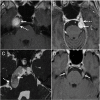Imaging evaluation of trigeminal neuralgia
- PMID: 29354310
- PMCID: PMC5750829
- DOI: 10.17096/jiufd.27242
Imaging evaluation of trigeminal neuralgia
Abstract
Trigeminal neuralgia is a debilitating pain syndrome in the sensory distribution of the trigeminal nerve. Compression of the cisternal segment of the trigeminal nerve by a vessel, usually an artery, is considered the most common cause of trigeminal neuralgia. A number of additional lesions may affect the trigeminal nerve anywhere along its course from the trigeminal nuclei to the most peripheral branches to cause facial pain. Relevant differential considerations are reviewed starting proximally at the level of the brainstem.
Keywords: magnetic resonance imaging; Trigeminal neuralgia; brainstem; facial pain; neurovascular conflict.
Conflict of interest statement
Conflict of interest: None declared.
Figures





References
-
- Yousry I, Moriggl B, Holtmannspoetter M, Schmid UD, Naidich TP, Yousry TA. Detailed anatomy of the motor and sensory roots of the trigeminal nerve and their neurovascular relationships: a magnetic resonance imaging study. J Neurosurg. 2004. September;101(3):427–34. 10.3171/jns.2004.101.3.0427 - DOI - PubMed
Publication types
LinkOut - more resources
Full Text Sources
Other Literature Sources
